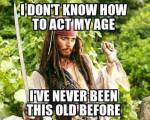 I’m illustrating this post with one of my favorite Facebook memes—the caption, in case you can’t see it, reads “I don’t know how to act my age. I’ve never been this old before.”
I’m illustrating this post with one of my favorite Facebook memes—the caption, in case you can’t see it, reads “I don’t know how to act my age. I’ve never been this old before.”
To me, that sums up an ongoing struggle for a lot of us. Once upon a time, particular ages came with instructions. When you hit thirty or forty or fifty or sixty, you were supposed to look and behave in a certain way. And everyone knew what that way was. If you didn’t fulfill these expectations, you got a lot of social disapproval and a reputation as an eccentric.
But now the whole concept of age is undergoing a sort of revolution. Part of this phenomenon is the result of that great bump-in-the-python known as the Baby Boomers. From the time we were born, our sheer numbers have changed the dynamic around us, and now it’s happening with retirement and aging. But I don’t think this new view of aging is entirely due to the Boomer influence.
More often than not these days you reach a particular age and find yourself at sea. You remember your parents or grandparents being this old, but somehow you don’t feel the same. You’re simply not interested in orthopedic shoes and shapeless black garments, let alone silver hair (is there anyone out there who actually has the hair color they were born with these days?). Tradition tells you one thing, while popular culture tells you another. So are you supposed to act the way you feel or the way someone your age acts according to convention?
Just to make this whole matter that much more confusing, a lot of famous people no longer look and act like we expect people “of a certain age” to look and act. Rosanne Cash is 60. Bonnie Raitt is 65. Meryl Streep is 66. Susan Sarandon is 68, and so is Emmylou Harris. Helen Mirrin is 70. Blythe Danner is 72. Joan Baez is 74. Lily Tomlin is 76. Jane Fonda is 77, Vanessa Redgrave is 78, Judi Dench and Maggie Smith are 80, and Sophia Loren is 81. All of them are still working, and none of them has taken to her rocking chair with an afghan and a tabby.
So we’re back to the basic question: how do you act your age these days? The answer, so far as I can tell, is you act the way your age feels to you. There are some things I no longer do. I don’t wear heels anymore because I figured out what they were doing to my back (actually I stopped wearing them many years ago, but now I find even moderate heels uncomfortable). I’d rather wear leggings and tunics than dresses, so that’s what I do. I have no idea whether this goes with my age or not, and I don’t much care. But the don’t much care probably does have something to do with my age—one of the many benefits of getting a few years under your belt.
I don’t talk about age much myself, largely because I hate being put into boxes, and age is definitely one of those. I’ve found that when people know your age, they tend to attach a set of expectations to you. But I find the occasional media assumption that everybody past forty would like to be young again (as in this popular series) somewhat naïve. Each age has its own pluses and minuses. And these days many of us are trying to find our way through both.








